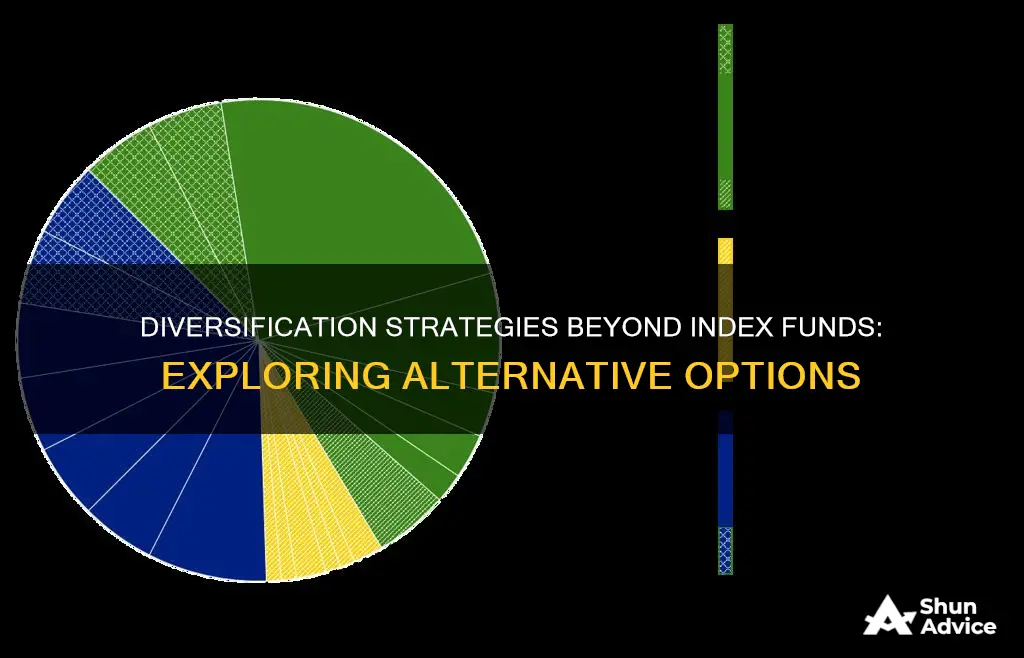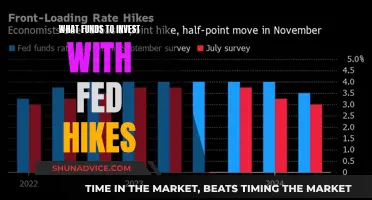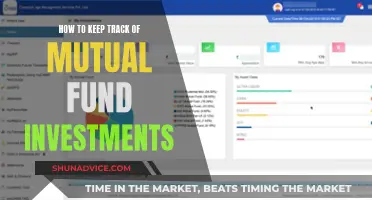
Index funds are a popular investment choice due to their low costs, diversification, and passive management strategy. They are a type of mutual or exchange-traded fund (ETF) that tracks a market index, such as the S&P 500, by holding the same stocks or bonds. While index funds offer broad diversification, there are other investment options that provide even greater diversification.
One option is to invest in multiple sector-specific index funds, such as those focused on technology, finance, or consumer goods. By investing in various sectors, you can further diversify your portfolio and reduce risk.
Another option is to invest in a fund of funds, which is a fund that invests in multiple underlying funds. This approach provides exposure to a wide range of assets and investment strategies, increasing diversification.
Additionally, you can consider investing in a broad market index fund, such as the Wilshire 5000 Total Market Index, which tracks thousands of publicly traded companies. This provides exposure to a diverse range of companies across different sectors and industries.
Finally, you can create your own diversified portfolio by investing in a variety of asset classes, such as stocks, bonds, commodities, and real estate. This approach may require more research and active management but can offer greater diversification than a single index fund.
While index funds offer the benefits of low costs and passive management, there are alternative investment strategies that can provide even greater diversification, depending on your financial goals and risk tolerance.
| Characteristics | Values |
|---|---|
| Type | Mutual fund or exchange-traded fund (ETF) |
| Investment strategy | Passive |
| Investment objective | To mirror the performance of a specific market index |
| Management style | Passive |
| Costs and fees | Lower than actively managed funds |
| Diversification | High |
| Risk | Lower than individual stocks |
| Tax efficiency | High |
| Performance | Matches the market's performance |
What You'll Learn

Index funds vs. active funds
Index funds are a type of mutual or exchange-traded fund (ETF) that tracks the performance of a market index, such as the S&P 500, by holding the same stocks or bonds or a representative sample of them. They are passively managed, meaning they don't actively pick securities or time the market. This makes them more diversified and less expensive than active funds.
Active funds, on the other hand, are managed by professionals who try to beat the market by hand-picking stocks or bonds that they believe will outperform the market. This requires a lot of research, analysis, and trading, which drives up costs. As a result, active funds have higher expense ratios than index funds.
When deciding between index funds and active funds, it's important to consider the risks and potential returns of each. Index funds are less risky because they are diversified and have lower fees, but they may not perform as well as active funds in a strong market. Active funds, on the other hand, have the potential to outperform the market but also come with the risk of underperforming and higher fees.
- Index funds are passively managed, while active funds are actively managed by professionals.
- Index funds have lower fees and expenses than active funds.
- Index funds are more diversified than active funds, which may invest heavily in a few specific stocks or sectors.
- Active funds have the potential to outperform the market, while index funds aim to match market performance.
- Index funds are better for long-term investing, while active funds may be more suitable for short-term gains.
In conclusion, both index funds and active funds have their advantages and disadvantages. Index funds are more diversified and have lower fees, making them a good option for long-term investors. Active funds, on the other hand, offer the potential for higher returns but come with higher risks and costs. It's important to consider your financial goals, risk tolerance, and investment horizon when deciding between the two.
Real Estate vs Mutual Funds: Which is the Better Investment?
You may want to see also

Mutual funds vs. exchange-traded funds (ETFs)
Index funds are a type of mutual or exchange-traded fund (ETF) that tracks the performance of a market index, such as the S&P 500, by holding the same stocks or bonds or a representative sample of them. They are defined as investments that mirror the performance of benchmarks like the S&P 500 by mimicking their makeup.
Index funds are attractive for several reasons, including diversification and low expense ratios. When you purchase shares of an index fund, you are exposed to all the stocks in an index. This means that stocks that are appreciating will make up for stocks that are depreciating.
Mutual funds and ETFs are similar in that they both represent managed "baskets" or "pools" of individual securities, such as stocks or bonds. They both offer exposure to a wide variety of asset classes and niche markets and can be used to create a diversified portfolio. However, there are some key differences between the two:
- ETFs trade like stocks and are bought and sold on a stock exchange, experiencing price changes throughout the day. Mutual fund orders are executed once per day, with all investors receiving the same price.
- ETFs do not require a minimum initial investment and are purchased as whole shares, while mutual funds have a minimum initial investment that is normally a flat dollar amount.
- ETFs are usually passive investments pegged to the performance of a particular index, while mutual funds come in both active and indexed varieties, but most are actively managed.
- ETFs are generally more tax-efficient than mutual funds, as they may have lower turnover and can use the in-kind creation/redemption process to manage the cost basis of their holdings. A sale of securities within a mutual fund may trigger capital gains for shareholders, even if they have an unrealized loss on the overall investment.
- ETFs offer more targeted investments that mirror a particular index, while mutual funds offer more diversification options and exposure to a broader range of securities.
- ETFs have lower expense ratios than mutual funds.
- ETFs allow investors to start with smaller amounts, while mutual funds typically require a higher minimum investment.
In summary, both mutual funds and ETFs offer a range of benefits to investors, and the choice between the two depends on individual preferences and investment goals. While ETFs are generally lower-cost and provide diversification, mutual funds offer a range of asset classes and the potential for tax-free gains over the long term.
Axis Bank's Mutual Fund Investment Options Explained
You may want to see also

Index fund costs
Index funds are a type of investment fund that tracks the performance of a market index, such as the S&P 500, by holding the same stocks or bonds or a representative sample of them. They are passively managed, meaning they aim to replicate the performance of a specific index rather than actively picking securities or timing the market. This passive management strategy allows index funds to have lower fees and expenses than actively managed funds.
Investment Minimum
The minimum required to invest in an index fund can vary, with some funds having no minimum while others may require a few thousand dollars. However, most funds allow investors to add money in smaller amounts after the initial investment.
Account Minimum
This refers to the minimum amount required to open an investment account, such as a brokerage account, individual retirement account (IRA), or Roth IRA, through which you can purchase an index fund. Some brokers may have a $0 account minimum for certain types of accounts, such as IRAs.
Expense Ratio
The expense ratio is one of the main costs associated with index funds. It is an ongoing fee charged by the fund company, typically calculated as a percentage of the investor's total assets in the fund. Expense ratios for index funds are generally low, often below 0.1%, but they can vary depending on the fund and the index it tracks.
Sales Load or Commission
Some index funds, particularly mutual funds, may charge a sales load or commission when buying or selling the fund. These fees can be avoided by choosing funds from investor-friendly companies that do not charge these fees.
Trading Costs
When purchasing an index fund through a broker, there may be trading costs or transaction fees involved. Mutual fund commissions tend to be higher than stock trading commissions, while ETFs may be traded without commissions through some brokers.
Tax-Cost Ratio
Owning an index fund may trigger capital gains taxes if held outside of tax-advantaged accounts such as a 401(k) or IRA. These taxes can reduce the overall investment returns.
Overall, index funds are known for their low costs compared to actively managed funds, making them a popular choice for investors seeking diversified, low-cost investments.
Target-Date Funds: Invest Now or Miss Out?
You may want to see also

Index fund performance
Index funds are a type of investment fund that tracks the performance of a market index, such as the S&P 500, by holding a representative sample of the same stocks or bonds. They are passively managed, meaning that fund managers do not actively pick securities or time the market. Instead, they aim to replicate the performance of the index they are tracking. This passive strategy results in lower fees and expenses compared to actively managed funds.
The performance of index funds depends on the underlying index they are tracking. For example, S&P 500 index funds aim to mirror the performance of the S&P 500 index, which has historically provided solid returns over the long term. As of July 2024, the Vanguard 500 Index Fund Admiral Shares (VFIAX), an S&P 500 index fund, had a 10-year average annual return of 13.11%, while the S&P 500 had a 10-year average annual return of 13.14%. This small difference in performance is known as the tracking error.
Index funds offer broad market exposure and diversification across various sectors and asset classes, depending on the underlying index. For example, the S&P 500 covers about 80% of all U.S. equities by market cap, providing investors with exposure to a diverse range of companies across different sectors. This diversification can help reduce risk, as the performance of the fund is not dependent on a single company or sector.
However, it is important to note that index funds can still experience market swings and declines, especially during prolonged downtrends. Additionally, they may lack the flexibility to pivot away from a declining market. Therefore, index funds are generally recommended for long-term investors with a time horizon of at least 6-10 years.
When investing in index funds, it is important to consider the fees and expenses associated with the fund, as these can impact the overall returns. Funds with lower expense ratios and minimal trading costs are generally preferable. Additionally, it is crucial to align the investment with your financial goals, risk tolerance, and time horizon.
In summary, index funds offer a simple, low-cost way to gain exposure to a diversified portfolio of stocks or bonds. Their passive management strategy and broad market exposure make them a popular choice for investors seeking long-term growth, particularly for retirement accounts. However, it is important to monitor their performance and fees over time to ensure they remain aligned with your investment objectives.
Mutual Fund Investment: NRIs Need Not Apply
You may want to see also

Index fund risks
Index funds are a popular investment choice due to their low costs, diversification, and ease of use. However, they are not without their risks, and here are some of the key considerations:
- Lack of downside protection: Index funds, such as those tracking the S&P 500, will give investors upside when the market is doing well, but they are also vulnerable to market downturns. While indexes tend to rise over time, investors are not shielded from losses during bear markets.
- Lack of reactive ability: Index funds do not allow investors to take advantage of specific opportunities. For example, if a stock becomes overvalued, it carries more weight in the index, but this is when investors would typically want to reduce their exposure.
- No control over holdings: Index funds are set portfolios, and investors cannot choose the individual holdings. This lack of control may be undesirable for investors who want to invest in specific companies they believe in or avoid companies that conflict with their values.
- Limited exposure to different strategies: Index funds may not provide access to successful investing strategies. Other strategies can be combined with index investing to provide better risk-adjusted returns and a portfolio better suited to personal goals and risk tolerance.
- Dampened personal satisfaction: Index investing can still be stressful during market turmoil, and investors may constantly check the market's performance. They also miss out on the satisfaction of making good investments and being successful with their money.
- Market risk: Index funds are subject to market swings and can participate in any market downturn, as evidenced by the S&P 500 losing roughly 38% in 2008. While indexes tend to recover over time, investors with a short time horizon may lose money if they cannot wait for the recovery.
- Lack of flexibility: Index funds are designed to mirror a specific market, so they cannot pivot when the market shifts. They are also criticised for automatically including all securities in an index, which may lead to investing in overvalued or weak companies.
- Concentration risk: Index funds that use market-cap weighting, such as the S&P 500, give larger companies a more significant influence on the fund's performance. This concentration can lead to being too dependent on the fate of a few large companies, increasing risks if these companies underperform.
- Tech tilt: The S&P 500's tech tilt is currently at a historic high, with the tech sector comprising 40% of the index's weight. This means that a significant drop in tech stocks could disproportionately affect the index.
- Underperformance: While index funds aim to mirror the market, they may not always succeed, and there is no guarantee that the market will always recover from downturns. Actively managed funds, on the other hand, aim to outperform the market, although they often come with higher fees.
Mutual Funds: A Million Dollar Dream?
You may want to see also
Frequently asked questions
Mutual funds and exchange-traded funds (ETFs) are two examples of investments that can be more diversified than index funds. These funds can hold a wide range of assets, including stocks, bonds, commodities, and cash, and they can invest in various sectors, industries, and countries.
The level of diversification that is right for you depends on your risk tolerance, investment goals, and investment horizon. As a general rule of thumb, it is better to be diversified across multiple assets, sectors, and geographies to reduce risk.
Investing in a diversified portfolio can help to reduce risk and volatility. When one asset or sector is performing poorly, others may be performing well, offsetting the losses. Diversification can also provide exposure to different economic factors and themes, which can help boost returns over time.
One potential downside of investing in a diversified portfolio is that it may be more difficult to generate high returns. When a particular asset or sector is performing well, a diversified portfolio will only have a limited exposure to it, which may lead to lower returns than a concentrated portfolio.
There are several ways to build a diversified portfolio. One way is to invest in a variety of assets, sectors, and geographies directly. Another way is to invest in mutual funds or ETFs that provide exposure to a broad range of assets. Additionally, you can use index funds as a foundation for your portfolio and then add other investments to increase diversification.







